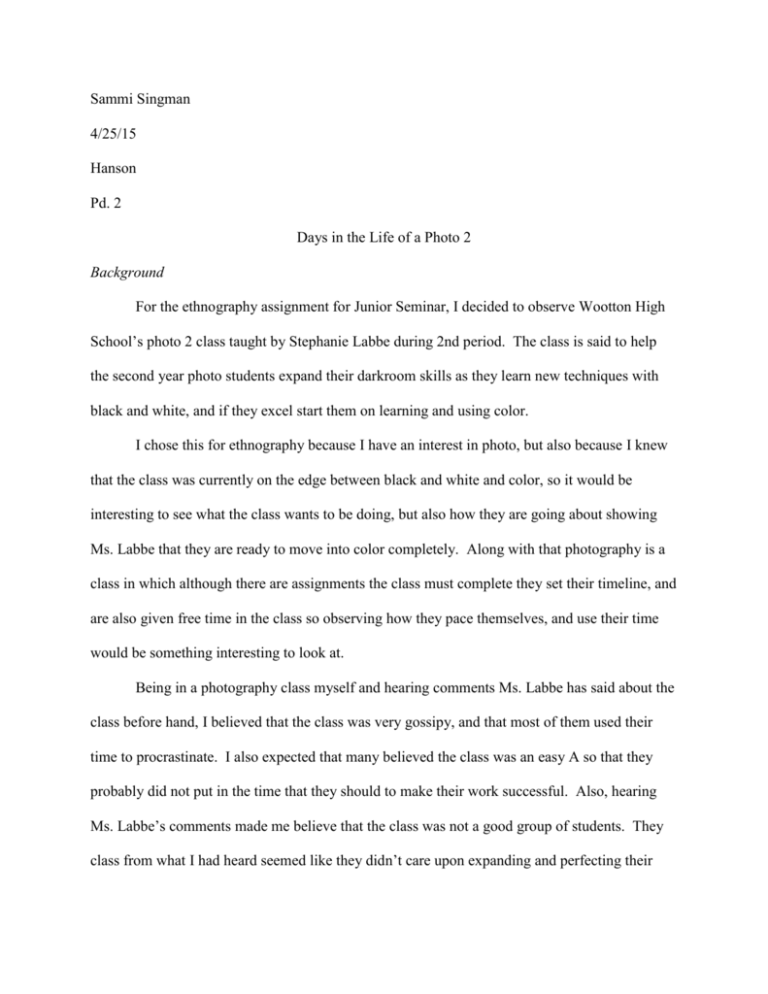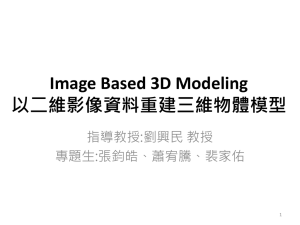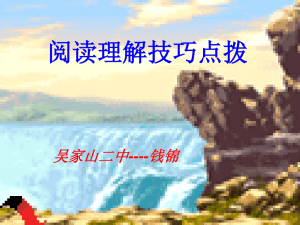Ethnography
advertisement

Sammi Singman 4/25/15 Hanson Pd. 2 Days in the Life of a Photo 2 Background For the ethnography assignment for Junior Seminar, I decided to observe Wootton High School’s photo 2 class taught by Stephanie Labbe during 2nd period. The class is said to help the second year photo students expand their darkroom skills as they learn new techniques with black and white, and if they excel start them on learning and using color. I chose this for ethnography because I have an interest in photo, but also because I knew that the class was currently on the edge between black and white and color, so it would be interesting to see what the class wants to be doing, but also how they are going about showing Ms. Labbe that they are ready to move into color completely. Along with that photography is a class in which although there are assignments the class must complete they set their timeline, and are also given free time in the class so observing how they pace themselves, and use their time would be something interesting to look at. Being in a photography class myself and hearing comments Ms. Labbe has said about the class before hand, I believed that the class was very gossipy, and that most of them used their time to procrastinate. I also expected that many believed the class was an easy A so that they probably did not put in the time that they should to make their work successful. Also, hearing Ms. Labbe’s comments made me believe that the class was not a good group of students. They class from what I had heard seemed like they didn’t care upon expanding and perfecting their skills, but just moving forward, and allowing their work to remain at the same quality as it was at. Research I had taken photo 2 before, and knew mostly what the class was about. The class would to use first semester expanding on their skills using black and white film, and then if they were completely successful with black and white the class would spend second semester using color film.. This would prepare them for the use of digital if they choose to continue their years of photography. Once assigned a project they have one-two weeks to shoot, develop the film, and print the required number of photos. When the project is due there is a critique where the class looks at all the photos and speaks about the overall strengths and weaknesses of it. Because they constantly need film and chemicals they are required to pay a $25 lab fee and purchase their own photo paper from the either Amazon of one of the few stores left open in the area. Before going into the class I decided to see where the class stood on their success with black and white. I was informed that due to constant begging they were given colored film, but that based on the outcome it would affect where they would go from there. Observation When I first arrived at Ms. Labbe’s class it was March 31st and they were critiquing one of their projects. According to Ms. Labbe “there were no guidelines” with the original project because she wanted to see how they used color theory. But the project they were critiquing that day though involved them using their color film to make successful black and white photos. I arrived at the classroom at 8:20. Ms. Labbe was not in the classroom, but her class was already starting to prepare for their critique. They were passing the 2 rolls of masking tape around and either ripping it piece by piece, causing impatience from the other students or moving quickly ripping one long piece and passing it along. At 8:21 as Ms. Labbe walked in her class recognizes the sound of her shoes tapping on the tile floor and they say “Happy Birthday!” But then one curious student brings up the pineapple on her desk, causing the whole class to question why she has a box of fresh pineapple. It turns out it was a birthday gift from another teacher, but Labbe focusing on the class getting their project up told them to still hang it up if “don’t have their third color” photo. So at 8:26 some of the class starts to walk outside and place their photos on the wall, while many linger in the classroom gossiping about “Emily.” Soon there are 2 left in the classroom Lily and Boy B. In this time Lily asks the boy about one of his photos and he made clear that he did not follow the little project guidelines. At this point its 8:30, and I decide to join the rest of the class in the hallway, and leave Lily and the boy to finish getting the tape on their own. In the hall the students line themselves up all with their backs against the wall, most with their legs sticking straight out, but some sit “criss cross apple-sauce” like they are in elementary school again. They face the wall of photos silently comparing their photos to their classmates. One boy doesn’t even look at the photos but sits silently and runs his hand through his hair repeatedly. While waiting for Ms. Labbe to walk out Amy with her 3 friends discuss ice cream flavors and what the true difference is. Soon Ms. Labbe comes out and all goes silent. She looks at the photos and sees that one person is missing one, but as she says something Lily walks out with the missing photo, and Boy B follows shortly coming out with his photos taped on top of one another and sloppily hangs them crooked on the wall. Once all the photos are up at 8:35, Ms. Labbe asks the class what the difference between the black and white and color images are. One girl explains using the someones image of a sunset to explain that the color images overall are a lot stronger than their black and white images, which Boy A think this is because they “all hate black and white at this point” and did not try as hard in the darkroom. But Amy disagrees arguing that “color isn’t better. it depends.” To which Lily says “colors adds more life.” At this point Ms. Labbe does not look happy. She looks over all the photos and says that only one person was successful in both black and white and color. As she starts to talk about color scheme and why this one person photos are successful, a staple gun goes off in the background distracting Ms. Labbe and the class for a few seconds, but when their attention is all turned back, the tone of voice of each student and Ms. Labbe change as the compete with the sound of the stapler. As she speaks, people’s positions stiffen, as they are anxious over her opinions of their photos. Two students, Amy and Kayla both raise their hand to say the same thing, but Kayla got to it first to say that their color images are better because “[they] see in color.” Ms. Labbe now changes her face, that the class can all see she is angry. At this point I got the idea that she was not going to give them another color project again because they were never successful enough in black and white to translate the colors in to black and white like they should have been doing since they started in photo 1. Ms. Labbe asks if anyone else has any comments on their photos before moving on with critiques. And many students had recognized how they could improve, but only one student admitted that his “photos were not as good as they could have been.” Ms. Labbe clearly still wanting to be able to improve their black and white skills asks the class how they can improve it, and only Girl C comes up with the correct answer which is to focus on composition. From there Ms. Labbe asks the class where to go next and while most shout “digital, ” one or two say “more color.” From my interview with Ms. Labbe I asked her why she was not giving her class the digital option and she explained that “it is more difficult to control the light in color. So if you can’t master black and white, you can’t master color.” The class though knew she would not give them digital, so they say they would prefer color because they are “unmotivated to print” because they “felt rushed” with the projects, annoying Ms. Labbe even more because the class is not taking advantage of all the opportunities to be working in the darkroom, and because of this she does not think they are ready for digital because her goal of having them successful in both color and black and white is not met. Amy, who was “really proud” of her color images asked if they were successful in color and upon hearing that they were not, asked what Ms. Labbe wanted for them. In class Ms. Labbe was not as clear as she was with me in my interview with her. In class she explained how they were not creative enough, and that she could tell the all only shot within a “10 mile radius of their house.” When I talked to Ms. Labbe about how she thought she could help them improve their creativity, she thought it was not what she could do, but “if they want to” because it all “comes down to a choice [they] make.” They all expanded their creativity on their midterm in January and from there it has “gone downhill.” Many of the students such as Tatum Amate, also realize this and know that Ms. Labbe does not want them to face a “decrease in [their] creativity.” They talk as a class on what they can do, and the class feels that they need to have more guidelines than a free shoot. “Why do you need guidelines?” The class all gets anxious now. One girl rubs her feet back and forth on the ground, another boy starts biting his nails, and another starts moving his fingers around. The class does not respond and she then releases them back into the classroom to turn in the photos. It is now 8:57 when the class is all back inside the room. They put their pictures in the pocket protectors, scramble to find rubrics and by 8:59 they are all around the binder trying to turn the photos in. While this is happening a new kid, a boy, walks into the classroom, and joins Boy A in his corner of the room. When the crowd around the binder dies down, the class spreads out to their “small group of friends” and has some free time. Lily sits alone at a table in the corner, Tatum and 2 other girls, who are not in the photo 2 class but are interns gossip in the corner, Amy sits in a 3rd corner with 3 other friends, and then in the fourth corner the rest of the class gathers around a table to chat. Amy and her friends sit in the back corner. There are 4 of them all together (Later I gathered that the other three’s names are Jack, Breece, and Rachel) and they are all sophomores. Breece has gatorade with her and although she tries to study with the other 3 she is constantly drinking her gatorade and not looking at the papers. They are studying for English and figuring what different terms of writing mean. Breece also has cookies and granola bars that she and Jack share. During this time Amy and Rachel are turned towards each other and talk while on their phones. Kayla and her friends during this spare time also spend it on their phones with each other. They are all either on their phones while talking to one another, or just holding and playing with it on the table in front of them. One girl, Seerun, has her earbuds in and walks back and forth between the windows, and her table diagonal from them in order to get reception to do whatever she was trying to do on her phone. That group in general was the loudest bunch in the room. They are always doing something or moving around making noise. Boy A and his random friend in the classroom spend the time talking about their futures, the “end of the world” and requirements for the Navy because both of them want to go to the Navy after they finish high school. Lily in her own little corner is only in the room for their spare time until 9:03. She asks Ms. Labbe if she could go to the library to do homework, and spends the rest of the class there. At 9:09 Seerun is already at the door waiting to leave the classroom, and at 9:10 when Labbe releases the class she zooms out the door. The rest of the class takes their time, but still leaves fairly quickly. Everyone on their way out though tells Ms. Labbe “Good-bye!” When the class is all gone, and I am finishing my final notes, Ms. Labbe asks me to stay to see what I thought of the classes work and to see if she was too harsh on them. In my opinion from what I gathered about the class they were very dependent on filters, and just viewed things the way they were. I compared this back to projects I had received in photo 2 that helped me expand as an artist, and with that I gave Ms. Labbe the idea “to give them the [next] project.” When I returned to the class on April 15th Labbe was assigning the project that I helped her come up with, but with a twist. At 8:25 the whole class was gathering in the center of the room in front of the board, some with notebooks and pencils, to see the slideshow for their new project. The board read “Found Letters.” Although I had come up with the idea for the class to have the project ultimately Labbe had gotten the idea a few years back when “Mr. O’Neill did one” for her hallway display of teachers photographs. At 8:27 Labbe walks over and starts the class by announcing the obvious and sharing that they are all “getting a new project.” With that the powerpoint begins. Slide 1 has the objectives. The main (and only) objective is that the class uses “letters found in the environment” to make words. Daisley emphasises this by telling the class that they need to “go into the environment” to get the letters. She then shares that she will have examples of just the letters but also examples of what she expects the class to turn in. Because the class needs to turn in 5 images that when put next to one another spell a word, the images need to “both stand alone and work together.” Kayla at this point asks about how to tell what a letter is, which is a point that Ms. Labbe wanted someone to bring up. They need to use their creativity to see the letters. Soon the first example is put up and I look around the room to see how the class is reacting to what is expected of them, but I also notice that although they all have notebooks only one is writing down what Ms. Labbe is saying. They are shown examples of A’s and E’s, and when the word “GRACE” is shown the class looks at it strangely because they all think that it says “Crack” instead. Two minutes later after they finish their discussion on if the word is “crack” or “grace” the word “JOY” is put up and as a joke Ms. Labbe makes sure the class knows how to read and asks them to read the word out loud so she knows. A few more word examples are shown and then the Guidelines are given, which is to print 5 different photos that when put together make a 5 letter word. Ms. Labbe also suggests that they print all photos on 5x7 paper in order to keep the pictures looking organized and so it is not “too big or too much.” The class doesn’t really focus on the guidelines because they are too worried about the format it will be in. They keep asking if it is color or black and white, but Daisley asks them to hang on and then switches the slide. The next powerpoint slide says in huge letters that the project is “Seniors Choice” and they get to decide if it will be a black and white or color project. Before sending the seniors off to decide, Ms. Labbe gives them two scenarios. The first is for black and white. If the seniors pick this they need to turn in 5 prints on April 29 but they would have to develop their prints with no filters (what helps add contrast to their photos) and their next project would be using filters on the same 5 prints to better improve them. If their pictures were good the first time around they would be excused for the second project. The other option was color. The color pictures would be due on April 20th, they would need to turn in all of their 36 pictures (because it is the store developing not them), but still display the 5 that make a word. The next project following color would be turning their word images into black and white photos and that would be due April 29th. Then she shows them the schedule for the next week that would include PARCC testing and how their class would be interrupted. They would have 85 minutes to work on Tuesday, plus the darkroom would be open for them the mornings of the delayed openings. At 8:39 the 4 seniors, Tatum, Saman, Boy B, and Lily, all got to the back corner away from the class and discuss. Upon first gathering in the corner they seniors “were split evenly” but as a group they “weighed [their] options” and they says that there were “more benefits with black and white.” While the seniors discuss the project, the rest of the class looks around at each other and quietly whispers to their friend which one they hope the seniors pick. At 8:41 the seniors return and announce they are doing the project in black and white. Ms. Labbe switches back to the black and white slide and has the class either write down or take a picture of the black and white guidelines. As they do that many students in the class look annoyed. Amy had wanted “the seniors to pick color” because she thought it would make “the pictures much more lively and interesting,” but like the rest of the class was stepping up to the plate because she knew “[she] would be able to do it.” Because they can’t use filters for their project, Ms. Labbe then asked the class if they had any questions on achieving good contrast. Jack wanted to know if it was just a matter of balance. To answer his question, Ms. Labbe got a lens for her desk, and went over what they did in photo one and learning what aperture is and how it works with shutter speed to create good contrast. The lens gets passed around so the class can observe that with each click of the ring turning the light inside the camera would be doubled or halved. The class starts to look even more frustrated. Labbe asks if anyone has any last questions, and when no one does at 8:50 Labbe says she is done and sends the class back to their seats. The class once again dispersed themselves among their small little groups. Amy and her friends in the same corner, Kayla and her friends in theirs, Lily back at her own little table, Tatum at the computers, but this time Boy A is not there and instead Saman sits at the table behind Lily on his own. Lily uses this time to do work. But as she starts to work, she stops and goes to Ms. Labbe to ask for film, and is then assigned the job of handing out the film. Once she finishes, she returns the extra to Ms. Labbe and gets back to work. She does through her binder, leaves the room, comes back and continues to work. She bounces her foot as her works, and puts her stuff away at 9:05 to instead take out her lunchbox to eat an apple until the end of class. Saman spends the class period also doing work. He works straight through the class until 9:09 where he takes out his lunchbox and pulls out his sandwich. He takes 2 bites of it then packs up because the class is over. Kayla and her friends spend the class talking about random subjects. Once again they all have their phones out. They talk about APs and which ones they are planning on taking. They also talk about colleges and what they plan to study and drop in college. One of Kaylas friends, a girl in pink and Boy B have a separate conversation while she plays a game on her phone and he bounces a stress ball on the table. Another girl at that table, Seerun, is constantly moving around the room. She takes out her apple, then goes to plug in her phone while eating the apple, goes to the trash can, goes back to the table for her sandwich, then to the trash, back to the table for pretzels, then to get her phone and back to the trash can and then finally stops and stays at the table. She has her headphones in but still tries to participate in her friends conversations. At 9:06 Seerun grabs her backpack and walks over to the door waiting for the class to be released. Amy and her friends sit in the corner. Breece and Jack spend the class eating cookies, drinking their water and sharing granola bars. They also have papers in front of them, trying to do work they have due later in the day. Amy and Rachel talk for a while switching their tone between a soft whisper and loud laughing and shouting. At 9:02 they decide to put their time to use and come up with a word to use for the project. They look up words like “crazy,” “quote” and “joker.” Soon Breece and Jack join the conversation and discuss words they want to do too. Breece makes a comment about how she wants to drop a letter from her name while Amy suggests that Jack do the word “Crack” because of the conversation earlier. Tatum instead of staying in the corner this time goes to talk to Ms. Labbe about Wootton theater. They talk about past shows, how they were both better and worse than currently. They also talk about how the leadership used to work. Overall their conclusion was that theater today is a lot different than it was. At 9:10 Ms. Labbe releases the class. Seerun, Lily and Saman are the first to leave. Amy and her friends are next; they push in their chairs and say “goodbye” to Ms. Labbe and she says “bye guys” back. Kayla and her group are next. They leave their chairs scattered and just walk out. Once everyone is gone Tatum grabs her stuff from the computers, tells Ms. Labbe that she will see her later and walks out. Analysis and Conclusion After visiting their class, and conducting interviews, I learned that not all of the class is as bad as I had heard. Plenty of students want to produce the best work they can and will use every opportunity to do so. Tatum for example enjoys the class so much that “[she’s] majoring in it in college” so this class and doing well is very important to her. Amy too wants to succeed becuase she likes being able to share and “capture [her] ideas and perspectives” but feels that her class is holding her back. Ms. Labbe puts in a lot of work to try and get the class to succeed and she takes the time to figure out ways that will allow them to be creative while at the same time learning and mastering new skills. She cares a lot about her students and wants them to succeed. This class although an art class is not an easy A, but an A is also not impossible to achieve. If the class put their heart and soul into the class, whether it is their best work or not they can succeed. The class is put there to expand your creativity and in some cases help you build and prepare you for the future. Ms. Labbe really wants to achieve that; their success is her success. “Think left and think right and think low and think high. Oh, the thinks you can think up if only you try” – Dr. Seuss 1 1 http://twistedsifter.com/2012/03/15-famous-quotes-on-creativity/ Amy Berger’s found letters project







